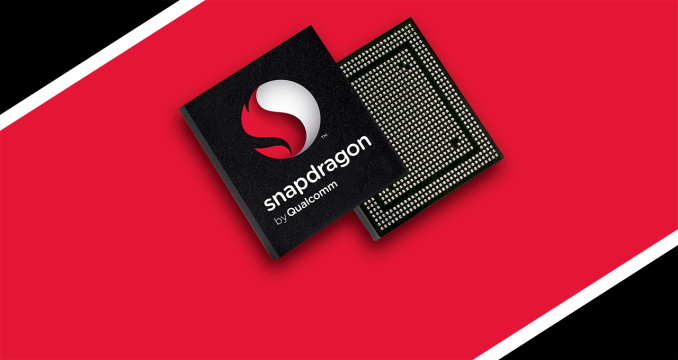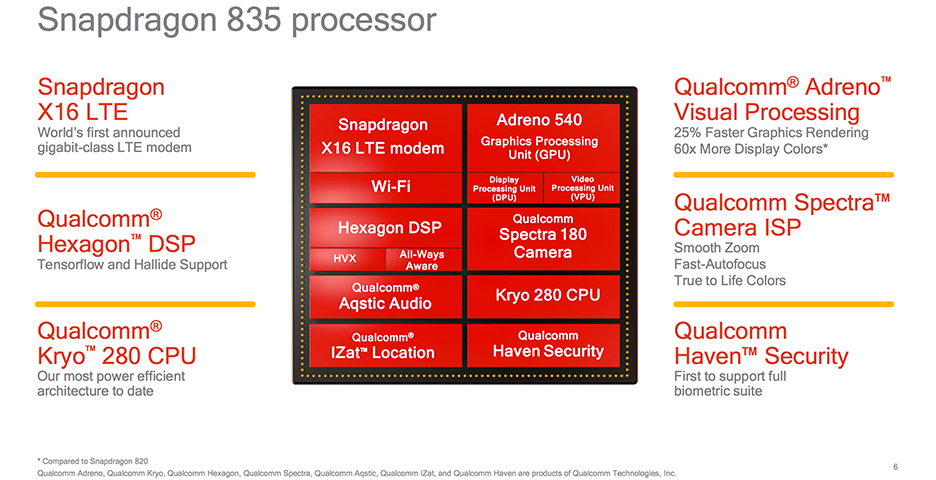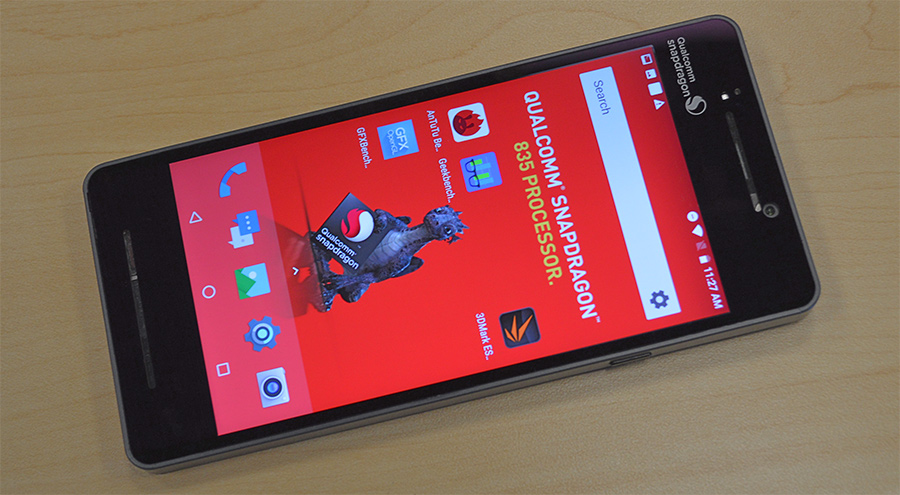The Qualcomm Snapdragon 835 Performance Preview
by Matt Humrick & Ryan Smith on March 22, 2017 4:30 AM EST- Posted in
- Smartphones
- Snapdragon
- Qualcomm
- Mobile
- SoCs
- Snapdragon 835
- Kryo

The Snapdragon 820 SoC was a significant milestone on Qualcomm’s roadmap. It was a solid improvement over the 808/810, delivering higher performance and efficiency, and became a commercial success, finding its way into the majority of flagship phones last year. More importantly, it heralded Qualcomm’s vision for mobile devices: heterogeneous computing. This meant new hardware—a much improved Hexagon 680 DSP that added single instruction, multiple data (SIMD) Hexagon Vector Extensions (HVX); Qualcomm’s first fully-custom 64-bit CPU core, Kryo, which focused on improving floating-point IPC; and an updated Adreno GPU with strong ALU performance—for enabling new software technologies and user experiences—artificial intelligence for smarter personal assistants, machine learning for object recognition, computational photography for better image and video quality, and new AR/VR experiences.
Snapdragon 835—now a part of Qualcomm’s Snapdragon Mobile Platform that includes all of the company’s mobile hardware and software—is an evolutionary product that builds on this vision. The greater than 3 billion transistor SoC is the first to use Samsung’s 10nm "10LPE" FinFET process, which reduces overall package size by 35% relative to Snapdragon 820. The new SoC’s CPU transplant and X16 LTE modem, which tops out at 1Gbps (Category 16) on the downlink, are the biggest changes, but most of the other blocks within the SoC have received at least minor updates too. For detailed information about all the changes and new features, you can read our Snapdragon 835 launch article.
| Qualcomm Snapdragon SoCs: Three Generations | |||
| SoC | Snapdragon 835 (MSM8998) |
Snapdragon 820 / 821 (MSM8996 / MSM8996 Pro) |
Snapdragon 810 (MSM8994) |
| CPU | 4x Kryo 280 Performance @ 2.45GHz 4x Kryo 280 Efficiency @ 1.90GHz |
2x Kryo @ 2.15GHz / 2.34GHz 2x Kryo @ 1.59GHz / 2.19GHz |
4x Cortex-A57 @ 2.00GHz 4x Cortex-A53 @ 1.50GHz |
| GPU | Adreno 540 @ 710MHz ? | Adreno 530 @ 624MHz / 653MHz | Adreno 430 @ 630MHz |
| Memory | 2x 32-bit @ 1866MHz LPDDR4x 29.9GB/s |
2x 32-bit @ 1866MHz LPDDR4 29.9GB/s |
2x 32-bit @ 1600MHz LPDDR4 25.6GB/s |
| ISP/Camera | Dual 14-bit Spectra 180 ISP 1x 32MP or 2x 16MP |
Dual 14-bit Spectra ISP 1x 25MP or 2x 13MP |
Dual 14-bit ISP 1x 21MP |
| Encode/Decode | 2160p30 (2160p60 decode), 1080p120 H.264 & H.265 |
2160p30 (2160p60 decode), 1080p120 H.264 & H.265 |
2160p30 (2160p60 decode), 1080p120 H.264 & H.265 |
| Integrated Modem | Snapdragon X16 LTE (Category 16/13) DL = 1000Mbps 3x20MHz CA, 256-QAM UL = 150Mbps 2x20MHz CA, 64-QAM |
Snapdragon X12 LTE (Category 12/13) DL = 600Mbps 3x20MHz CA, 256-QAM UL = 150Mbps 2x20MHz CA, 64-QAM |
Snapdragon X10 LTE (Category 9) DL = 450Mbps 3x20MHz CA, 64-QAM UL = 50Mbps 1x20MHz CA, 16-QAM |
| Mfc. Process | 10nm LPE | 14nm LPP | 20nm SoC |
In what has become an annual tradition going all the way back to Snapdragon 800, Qualcomm invited the media to its headquarters in San Diego for some feature demonstrations and limited testing using the company's Mobile Development Platform (MDP) devices. These are fully functional tablets or smartphones in a slightly oversized, utilitarian chassis used for hardware testing and software development. The MDP for Snapdragon 810 took the form of a tablet, while Snapdragon 820 came inside a large smartphone with a 6.2-inch display. This downsizing trend continues for Snapdragon 835, whose MDP/S is a smartphone with 6GB of RAM, a 5.5-inch 2560x1440 display, and a small 2850 mAh battery. The use of a smaller chassis is encouraging, because it has less mass and surface area to absorb and dissipate heat. This suggests a lower TDP for the 835, but we'll need to measure power consumption to be sure.
Because we only had a limited time for testing, we focused on running some basic CPU, GPU, and memory performance tests. Keep in mind that we were testing prototype hardware running pre-production software that resulted in a few hiccups. The condensed testing period also forced us to stray slightly from our usual testing methodology. Therefore, these numbers should be viewed as preliminary and could change by the time retail units begin shipping.












128 Comments
View All Comments
lefty2 - Wednesday, March 22, 2017 - link
The iPhone 7 also scores a lot better in BaseMark OS II as well. At that stage we are looking at 3 benchmarks where iPhone trounces the best Android - although you can pick minor problems with each benchmark if you want - the overall picture is that the A10 performs better.joms_us - Wednesday, March 22, 2017 - link
A10 is better than SD821 by small margin in Basemark, SD835 will demolish it.lefty2 - Wednesday, March 22, 2017 - link
I didn't see SD821, but the A10 beats SD820 by a huge margin (almost double):http://www.anandtech.com/show/10685/the-iphone-7-a...
joms_us - Wednesday, March 22, 2017 - link
Check this one...http://www.gsmarena.com/oneplus_3t-review-1531p5.p...
Meteor2 - Wednesday, March 22, 2017 - link
I thought the whole point of Geekbench was that it used specific compilers for each ISA specifically so it *is* comparable.melgross - Wednesday, March 22, 2017 - link
Yes, and that's important. Too many benchmarks, in order to have some kind of equivelance, don't compile specifically to a particular chip. They don't support specific functions, so it may not be a comparable test. They must support, and properly, all of the features of a chip family.BurntMyBacon - Wednesday, March 22, 2017 - link
@lefty2: "So, yankeeDDL is correct, Apple's A10 trounces everything else (in single thread, which is the most important in a smartphone)."1) yankeeDDL did not make the single thread qualification that you made. Nor was any benchmark outside of this review mentioned. Therefore, yankeeDDL was not correct, regardless of the accuracy of your take on the situation.
2) You are using a single data point to disregard the entire benchmark suite here. Disregarding the perfectly legitimate reasons why the reviewers have chosen to leave geekbench out of the review suite, this still only gives the A10 one more win. Even then, you are purposefully leaving out the multi core data point, which puts the A10 only slightly ahead of Exynos 8890 in the Galaxy S7. I suspect, but can't confirm, that the A10 would lose to both the Kirin 960 and the Kryo 280. Yes, single threaded performance is important, but the Geekbench workload clearly isn't representative of all workloads.
Don't worry, the A10 isn't suddenly slow. It still ranks among the fastest SoCs on the market and is even still the top dog for certain senarios. Furthermore, platform optimizations and better use of APIs (see the javascript and basemark benchmarks) will likely hide any minor deficiencies until the A11(?) is released.
lefty2 - Wednesday, March 22, 2017 - link
I disregard multi threaded because most smartphone apps don't use multiple threads. Even for desktop PCs, single threaded performance is more important that multi threadedDrumsticks - Wednesday, March 22, 2017 - link
Didn't anandtech do an analysis of Android a while ago and find pretty much the exact opposite? And that was like a year ago so it can only have gotten better since then.lefty2 - Wednesday, March 22, 2017 - link
If they did, it must have been a very flawed analysis. Most people agree that single threaded performance is always the most important.